Less Scrambling, More Reflecting: How We Can Better Teach about the European Colonization of Africa

Table of Contents
Every year thousands of teachers of world history teach about the problematically-named “Scramble for Africa”, and many of them make use of a popular classroom simulation that seems to have originated in the 1990s, based on what some teachers have told me. I remember first seeing pictures of the activity showing up on the closed Facebook Group AP World History Teachers, which began in December 2009. It seemed that the activity was designed to have students relive the experience of what it was like to be a European and to claim parts of Africa at the Berlin Conference in 1884-1885, and in many of the pictures it was predominantly white students playing games, such as rock-scissors-paper, to take turns picking parts of Africa.
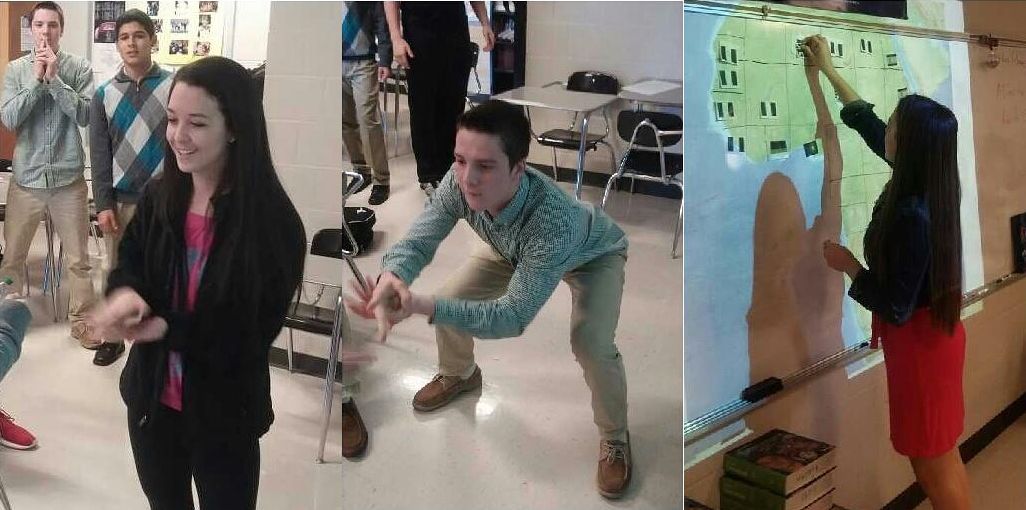
There was something about the nature of the simulation, the sensitive issues it turned into a game, and the way in which the horrors of colonization seemed to be minimized that made me cringe. I recalled the article “Classroom Simulations: Proceed With Caution” from Teaching Tolerance, in which Ingrid Drake discusses some of the problems with many simulations, as well as the ways in which simulations could be useful. She stressed that for many students, simulations can be quite difficult:
“Educators who oppose the use of simulations for emotionally vulnerable subjects generally point to three main concerns: the effects of simulations on children’s psychological development, the ability of simulations to oversimplify history and oppression, and the fact that few teachers possess the appropriate training to facilitate simulations successfully.”
After a few years of seeing posts by other teachers talking about how much “fun” their students had playing the game, and about how students “really got into it,” I shared my discomfort with the simulation to the rest of the group. (You can read the post if you have access to the closed group.) My post sparked a flurry of responses. Some teachers defended the simulation vigorously and some teachers accused me of trying to police behavior in the classroom. Many teachers talked about how they have students “debrief” the activity as way to justify the simulation. Another common response was that the activity put the students into the minds of the Europeans, and they could begin to think what the Europeans were thinking. I frankly was horrified by this defense, since I couldn’t imagine why I would want students not just to understand how the European colonizers thought, but also to behave in that way. Fortunately, many other teacherss thanked me for saying what they had already been thinking about the activity. These expressions of gratitude and similar feelings of frustration really helped me rethink how I teach about imperialism and the type of resources that more teachers need to help decolonize their world history classes.
In the rest of this post, I’m going to talk about a couple of strategies that I use for teaching about the colonization of Africa and share some strategy developed by other teachers. This post also introduces another new section of Liberating Narratives that will focus more specifically on lessons for world history teachers. “Liberating Lessons” will be a series of classroom lessons that are collectively authored by world history teachers and focus on the ways we can decolonize our world history classrooms.
Using Visuals to Understand the European Colonization of Africa
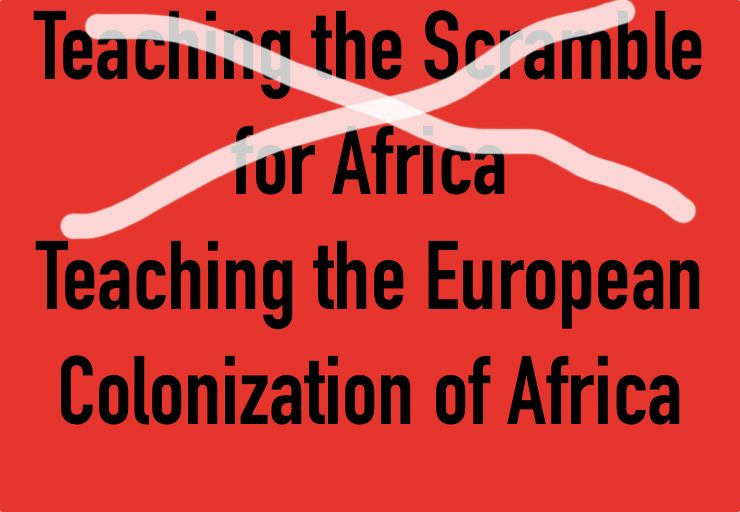
Almost every world history textbook has a discussion of the “Scramble for Africa.” We should start by simply never calling it that again. Scrambling suggests climbing up boulders or playing a game. Our language in the classroom matters. Europeans first claimed and then colonized Africa. After students read the material on the Berlin Conference and the colonization of Africa in their books, I use two well known visual sources to help students make sense of the Berlin Conference.
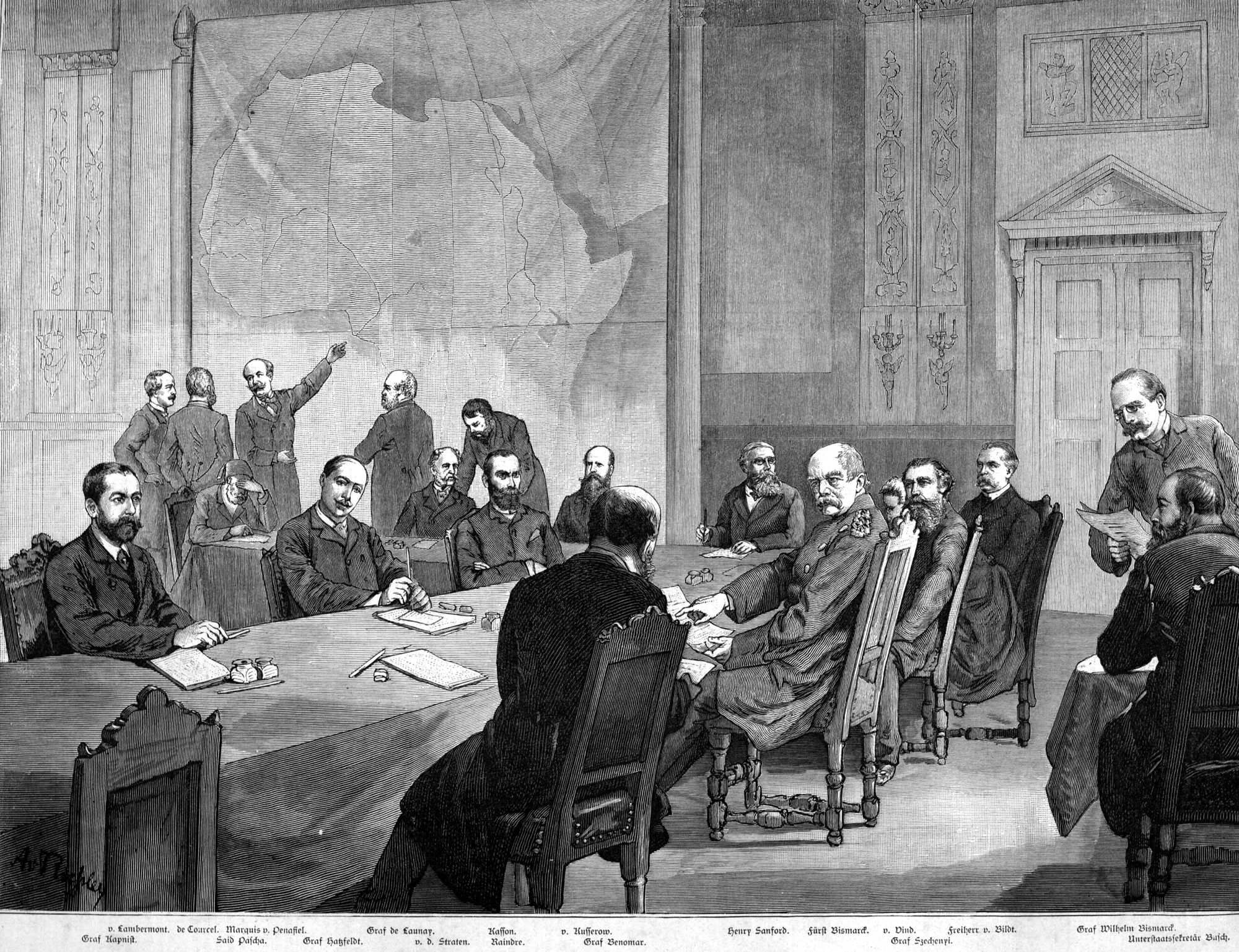
This image of the “Kongo Konference,” as it was known in Germany, comes from the German illustrated newspaper Illustrierte Zeitung. I begin by asking students to tell me what they observe. I always think students should start with observations before drawing any inferences. Students frequently notice the large number of European men wearing formal clothing sitting around a table and the large map of Africa in the background. Occasionally students will notice the one man sitting in the back left with his hand over his face. If they look closely, they will realize that he’s wearing a fez, and that he was Mehmed Said Pasha, the Ottoman Grand Vizir and representative to the conference. Having simply shared their observations, I ask students to think about the historical context, and then we begin to interpret the illustration. Most students quickly realize how strange it seems that a group of white men are sitting around in a room in Berlin claiming parts of Africa on a giant map while there are no Africans in the room. Some students will try to make sense of Mehmed Said Pasha. His hunched over posture and hand across his face makes it seem as if he was frustrated with the conference. (If you want to know more about the Ottoman role at conference, you can listen to Mostafa Minawi discuss his bookThe Ottoman Scramble for Africa: Empire and Diplomacy in the Sahara and the Hijaz on the Ottoman History Podcast or read about the discussion.
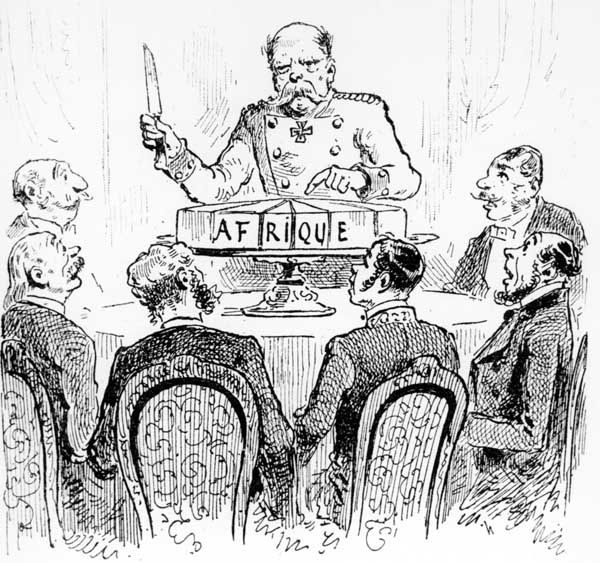
The second image is a popular French image depicting German Chancellor Otto von Bismarck using a knife to slice up a cake labeled “Africa.” Most students quickly jump to the conclusion that the cartoon is criticizing Europeans for “carving up” Africa, but a recent discussion of Victorian Imperialism on Dig: A History Podcast makes clear that the cartoon is not criticizing European imperialism, but instead the French “were unnerved that the newly-formed German state, led by Bismarck, was so brashly making demands and claims on land that the French, Belgians, British, Portuguese, and Dutch had been comfortably absorbing into their empires for decades.” In other words, no one was worried about carving up Africa, the other European diplomats were simply worried that the host of the Berlin Conference might cut himself too big of a slice of the cake that there would be nothing left for themselves. Using these two images helps students understand how Europeans thought and behaved at the conference without actually having to have students recreate the experience.
I also approach the Berlin Conference using two maps of Africa. I show the students this first map of Africa which contains all the different ethnic and linguistic groups in Africa.
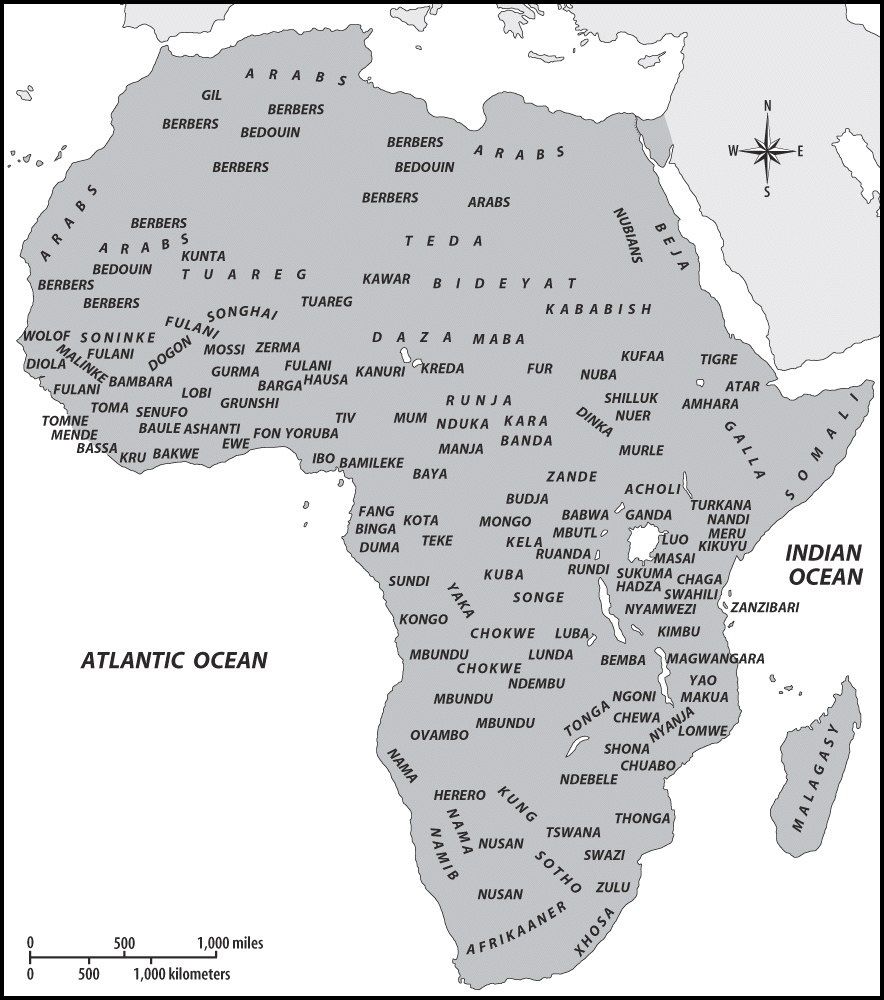
I ask them to make some observations, and they mostly focus on the diversity and number of groups. I then show a second map which has the political borders that Europeans eventually established and the ethnic groups.
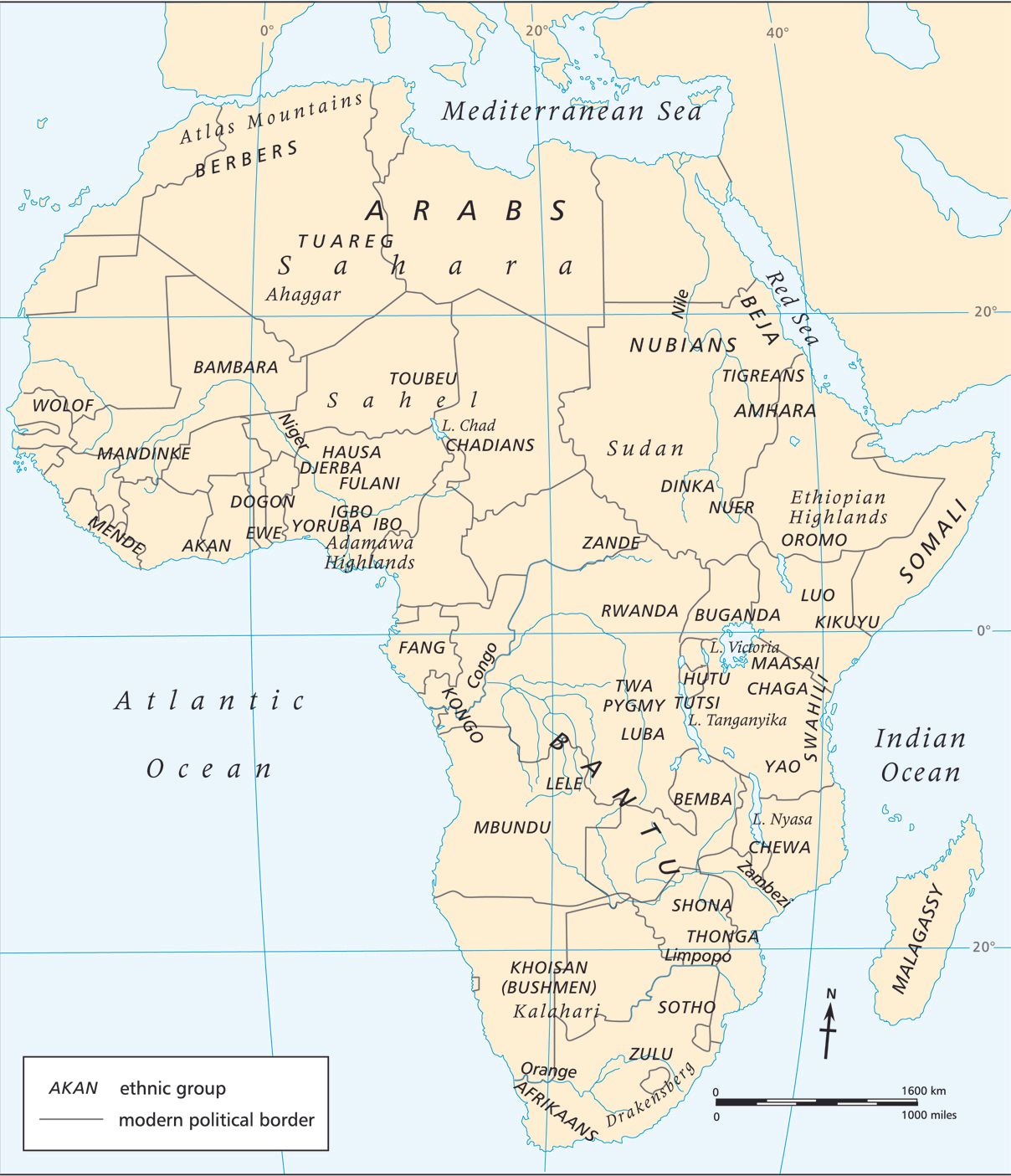
Students quickly notice how some ethnic groups, such as the Dogon, have been divided across multiple states, and some states, such as Sudan, have multiple ethnic groups within its borders. A few students might even notice that some states have borders that are perfectly straight lines extending for hundred miles, which makes sense if we remember that lines got drawn in Berlin. I will then ask students why those issues might be important, and they gradually begin to understand how those situations could eventually lead to conflicts between different ethnic groups within states or wars between states.
What I like about using these images and maps is that they get students to look at the European colonization of Africa from different perspectives and to consider how drawing lines on a map of Africa in a Berlin conference had real consequences for the peoples living in Africa.
Resisting Colonization
Although the images and maps help students understand the colonization of Africa in a more nuanced way, they don’t make clear the ways in which Africans actively resisted European colonization. In her book The Trouble with Empire: Challenges to Modern British Imperialism, Antoinette Burton argues that the story of imperialism should be less about outright conquest and more about continued dissent, disruption, and resistance. In relationship to Africa, Burton suggests “though it has made little impression in grand narratives of the Scramble for Africa, this insecurity was not abstract. Fear of colonial uprising and overrun was endemic to settler societies across the British empire, regardless of their longevity.” (174) To help my students better understand the continuous resistance of Africans to European rule, I use this map of African resistance to European imperialism in the late nineteenth and early twentieth centuries from Worlds Together Worlds Apart.
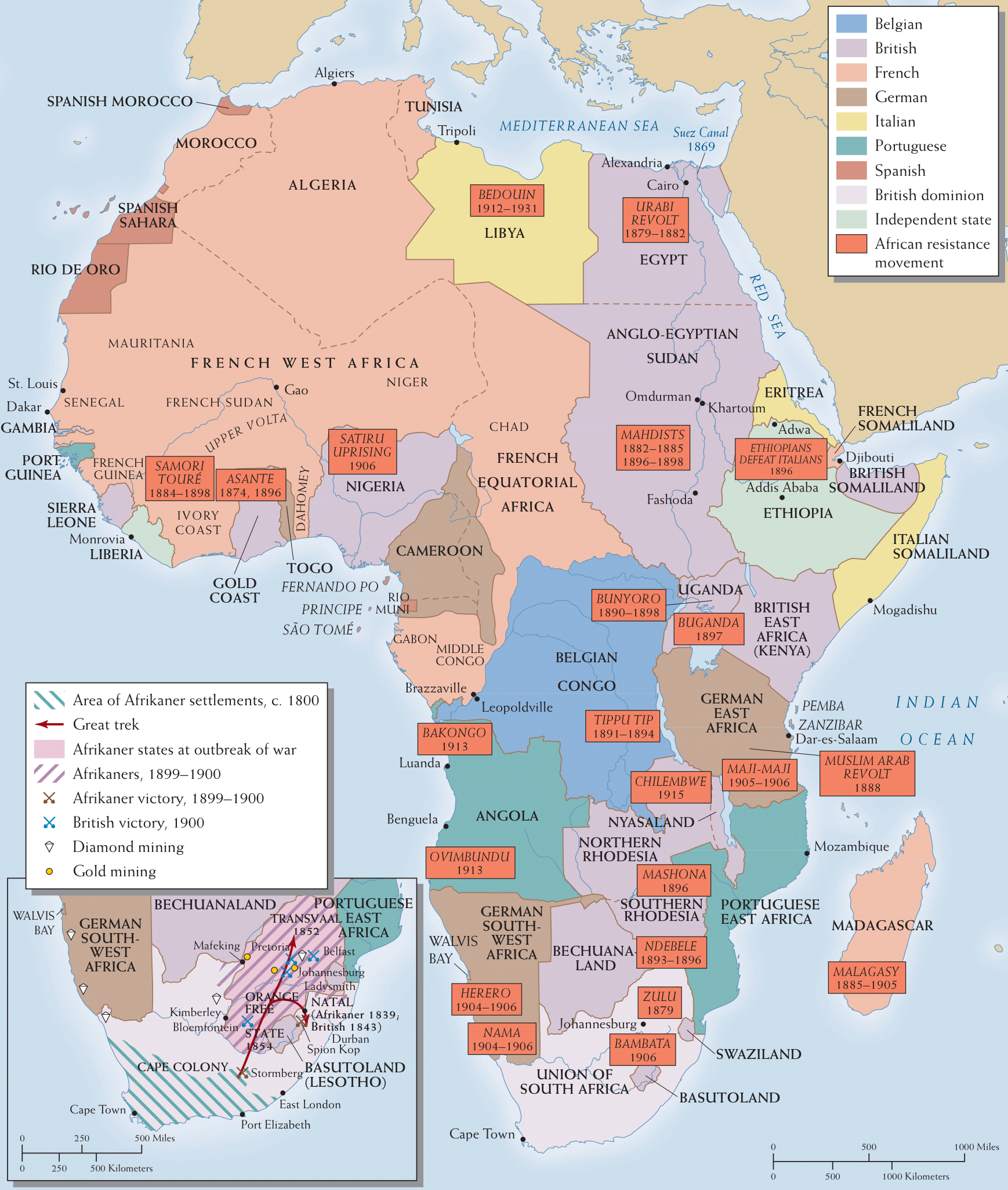
As students look at the maps, they quickly notice how most African colonies and independent Ethiopia resisted European colonization. Some African peoples even resisted on multiple occasions and for extended periods of time.
I recently posted this map on Liberating Narratives’ twitter account and Facebook page, and I quickly found out what it means to go viral. Within days, thousands of people had liked and shared the map with others. The comments were especially exciting to read, since so many people appreciated seeing imperialism being framed in terms of African resistance rather than European conquest. When we as teachers think about the messages we want to share with our students, I know that I want my students focusing more on the people who fought back and resisted imperialism rather than on coloring in squares on map with European conquests.
Michelle Tuyn, a teacher at Webster Schroeder High School, recently contacted me about an incredible lesson she put together. She used the map to create a miniature research project on African resistance for her students. She chose six of the resistance movements identified on the map, and had students research them. Students had to identify the causes of the resistance movement, the events of the rebellion, the outcome, and the consequences of the rebellion. Students then put together presentations, which they shared with the rest of the class. I love seeing how teachers are using something as simple as a map to build entire research projects and how the students are learning about these resistance movements which unfortunately receive minimal coverage in many world history textbooks.
To help students better understand the nature of resistance, I also use Ndansi Kumalo’s account of his participation in the Second Matebele War. Kumalo was part of the Ndebele people in Southern Africa, who twice fought against the British South African Company. Later in his life, Kumalo told his life story to a British African historian. In his account, Kumalo’s presents a compelling case of why the Ndebele people revolted against the British and why they lost. When juxtaposed with Frederick Lugard’s description of Africans having “a natural inclination to submit to a higher authority,” Kumalo’s account helps students to understand the ways in which Europeans minimized African resistance.
I also want to highlight the excellent lessons that Eric Beckman, a history teacher at Annoka High School, has been putting together on African resistance to European imperialism. We’ve worked together before, and he’s been sharing his resources and lessons on his blog “Learning, Online: Reflections on teaching history.” You can find more detailed discussion of his lessons here and here.
Conclusion
As I said four years ago in the private Facebook post when I first expressed my concerns about the Scramble for Africa simulation, I’m not trying to attack teachers who have used this simulation. Teachers are often overworked and given little time to plan lessons. Given that there are nearly 500,000 hits for a Google search on “Scramble for Africa simulation,” it’s not surprising that many teachers have used it. I’m more concerned about how many teachers don’t think about how that simulation could be experienced by students of color in our classroom. In many of our classrooms, we have students whose families and ancestors were victims of European colonization. How might it seem to those students to be asked to recreate the very moment when European diplomats claimed the lands that their own ancestors lived in? What sort of message are we sending to all our students when we take a brutal and dehumanizing conference and turn it into a game? And how do we create fun and engaging activities in our classrooms that challenge students to question history rather than accepting older, Euro-triumphalist narratives of the past?
Acknowledgments: I want to thank Eric Beckman and Michelle Tuyn for sharing their lessons with me. I also can’t even begin to acknowledge the hundreds of teachers with whom I have discussed this issue. I know you are doing incredible things in your world history classes. Thank you!
You can find the lesson “Understanding European Colonization of Africa and African Resistance” on the Lessons page of this site.
You can download Michelle Tuyn’s lesson on “African Responses to European Imperialism.” She has graciously shared it with many teachers.
Liberating Narratives Newsletter
Join the newsletter to receive the latest updates in your inbox.



